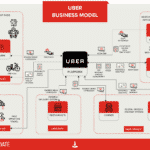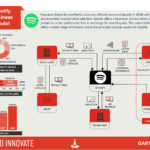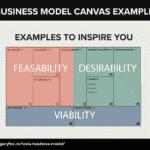Business model. Those two words are used by academics, business gurus and entrepreneurs – but exactly what is a business model?
A simple way to think of what is a business is to think about it in three parts:
- What are you creating – can you create something that customers want to buy – Feasability.
- Who are you go to market and sell it to? why will they want to buy it? – Desirability.
- The revenue model – how much does it cost to produce and market and how much will we make – is it profitable? – Viability.
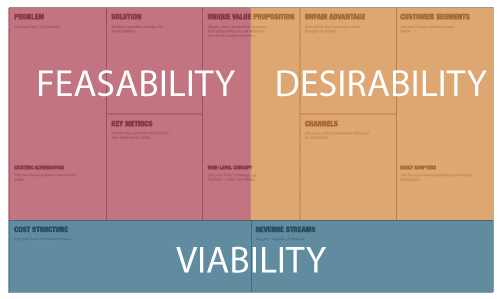
Creating and capturing value is – what do you produce (create value) and how much are customers willing to pay for that (capture value).
The value proposition is how you explain and communicate to customers what’s in it for them – why they should buy.
More specifically, business models refer to all of the activities you do in a firm, and the partners you use, to create your products or services and how you then distribute and market to your customers.
Underlying all of this is the revenue model, that is how you make money after you have paid for goods, employees and other resources and activities.
Don’t worry too much now about the definition of the business model. I’ve included loads of examples, plus some handy resources to help you understand it and use it.
Let’s begin.
If you aren’t clear about your business idea, your business model, then others won’t invest in your business.
A business model helps you to clearly express how the pieces of your business come together to create a product or service that customers will buy and enable you to make a profit.
Table of Contents
Why A Business Model Is Important?
A business model is a more effective way to compete because it is hard for competitors to copy a business model but relatively easy to copy a product or service.
If you’re starting a new business and want to immediately get traction with customers then you need to have an unbeatable business model.
Likewise, if you already manage a business but need to grow, then a powerful way to kickstart your ideas is to focus on reinventing your business model.
In this article, I will walk you through what is a business model and how to create one. This simple guide will help you master the art and science of designing your own business model.
This is why business modeling has become so popular. A business model helps you to take your business idea and think about deeply, explore different options and then pick the best solution.
What is the best solution? Ideally, we want a business that has unique features – an unfair advantage – that others can’t easily copy. Later in this article, we’ll take a look at why some business models are more successful than others.
Let’s take a deeper look into what is a business model and why it is important.
The Business Model Explained
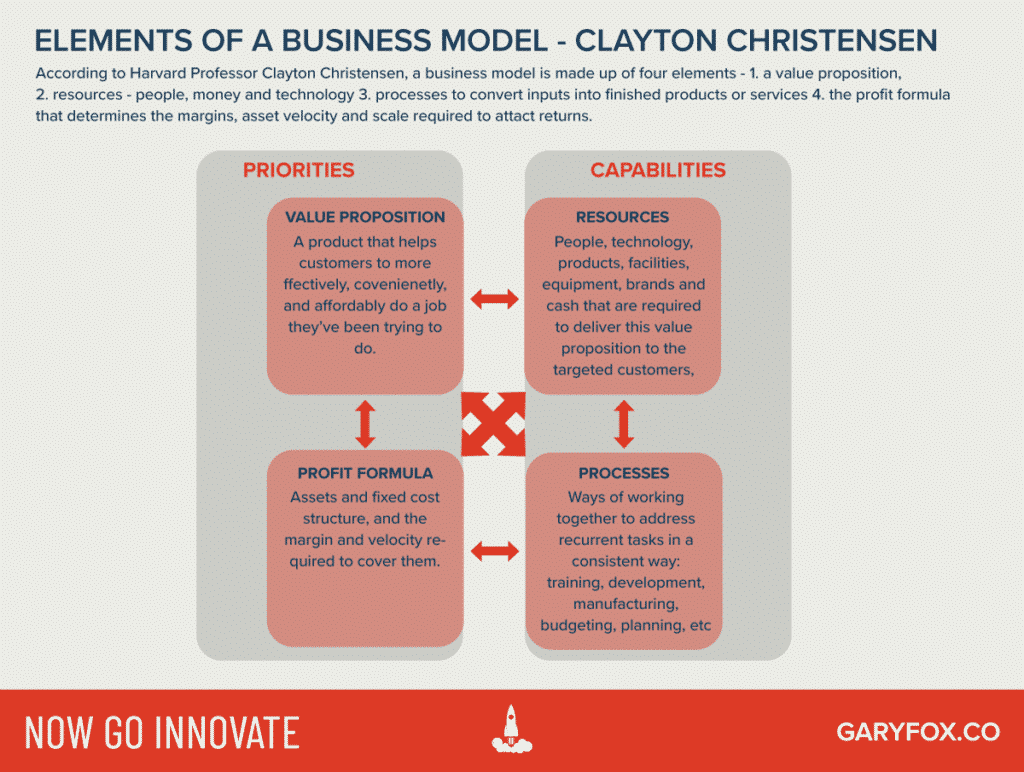
A business model is a framework to understand, design, and test your business idea. It provides a systematic way to identify how you can profitably generate revenue while creating value for your customers.
There is no one definition of what is a business model.
In the academic community, a business model is seen as a concept that lacks clarity. Many even think it shouldn’t even exist as a standalone topic and area of research. In fact, the one thing that academics do agree on is that there is no single definition of what is a business model.
However, in the real world, the business model has been used by hundreds of thousands of people. It has now become one of the most powerful forces for change and has given rise to a movement.
More and more people now use the business model design to shape their ideas and turn them into thriving businesses. But, it isn’t just entrepreneurs that have benefitted.
Large organizations, government institutions, and brands have used the business model approach to transform how they operate and reframe how they meet the needs of customers.
Harnessing the power of the business model generation has become a competitive necessity as the pace of change increases.
In recent years, the popularity of business models has given rise to lots of different business modeling frameworks. Some of which move beyond the normal concerns in business design, and consider issues such as sustainability and the circular economy.
These and other business model frameworks are covered in this guide.
Whether you are a startup or an executive in a large corporate brand, harnessing the power of business models and business model innovation is now a crucial skill.
Who Created The Business Model?
The roots of the business model concept can be traced back to as early as 1954, when Peter Drucker (Drucker, P. (1954), defined a good business model as one that answers the following questions:
Who is the customer?
What does the customer value?
How do we make money?
What is the underlying economic logic that explains how we can deliver value to customers at an appropriate cost?
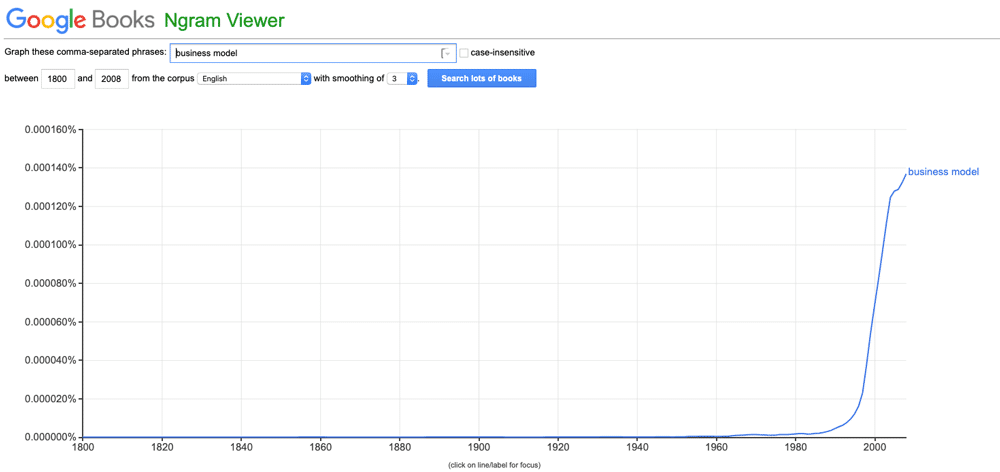
The first academic article using “business model” in its title was written in 1960! 1 Educators, electrons, and business models: a problem in synthesis. G.M. Jones. Accounting Review, 35 (4) (1960), pp. 619-626
Since then many people have tried to define what is a business model. As an example, Michael Lewis in his book the New, New Thing simply says that it is: “…how you plan to make money”. Further on in the book, he even refers to the business model as “a term of art.”
Joan Magretta describes a business model as a story that helps people to understand what a company does and how it does it.
But, perhaps the most post popular, and commonly used understanding of what is a business model comes from Osterwalder and Pigneur who created the Business Model Canvas. The business model canvas is a visual representation of a business broken down into 9 sections.
At the heart of the business model is the value proposition. The value proposition is how you create value for a specific set of customers. The other parts of the business model are about what resources you need, how you will reach your customers and how a company entices them to pay for value and converts those payments into profit.
The value proposition determines the WHY. Why will customers buy your solution? What’s in it for them? How do they benefit?
I’ll walk you through this and more as you read on.
designing good business models is an ‘art’ …. the chances are greater if entrepreneurs and managers have a deep understanding of user needs and are good listeners and fast learners.
David Teece – Scholar and Entrepreneur
What A Business Model Isn’t
A business is not a plan nor is it a strategy. A strategy is concerned with long term goals and a plan of action designed to achieve them. A business plan, on the other hand, is focused on how to implement a strategy.
3.1 A Business Model Is Not A Business Strategy
A business is not a plan nor is it a strategy2 Business model: What it is and what it is not’, Long Range Planning. DaSilva, C. M. and Trkman, P. (2014) .
A business model is concerned with how you design your business to:
- meet customers’ needs (offer something that they want to buy).
- generate a profitable revenue stream from sales.
- build a business that has a sustainable competitive advantage – in other words, it can’t easily be replicated.
- provide opportunities for growth.
Essentially, using a business model helps you make better decisions about your business.
For established businesses, it improves how teams make decisions about the future of the business.
For startups, it helps entrepreneurs formulate the best solution to meet customers needs and at the same time be profitable. Whenever I use with entrepreneurs they end up with a much deeper understanding of their options and how they need to put a business together.
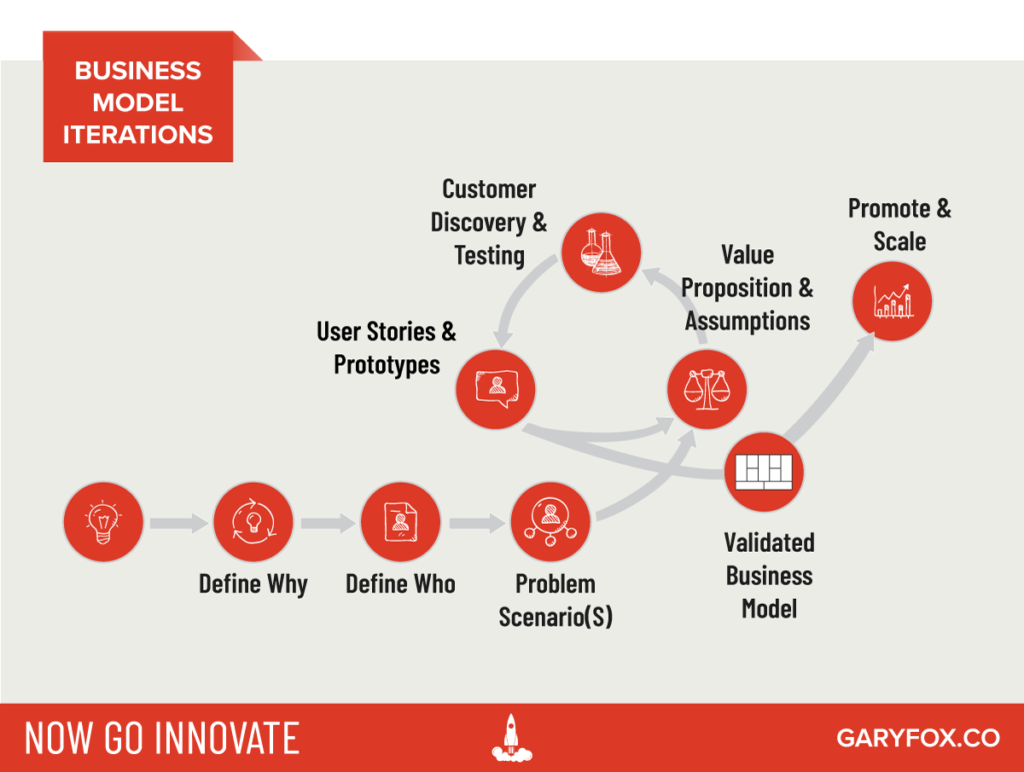
A business model isn’t the same thing as a strategy, even though many people think they are similar. A business model is concerned with a firm whereas a strategy takes into account the overall environment the firm operates in.
The business strategy determines which markets a company will operate in, what investments it will make and how it will compete. The goal of the strategy is to develop a sustainable competitive advantage.
Why? Well, you don’t want to carve out a great business only to find one year later another business or several businesses have stolen all your customers, often improving on your initial idea.
Your competitive advantage is always relative, it’s not absolute. What I mean by that is everything changes, constantly shifting, so you need to ensure that you are vigilante and identify how you can adapt your business as others chase and compete for your business.
A business that achieves superior performance relative to other competitors in the same industry or the industry average has a competitive advantage.
A business strategy guides you to choose one, out of many business models, is the best way to compete in your market.
3.2 A Business Model Is Not A Business Plan
There are two different types of plans that often get confused.
- Business plan – the firm’s intention on how to implement its strategy.
- Strategic plan – how a frim will compete given its resources, capabilities and the dynamics of the environment.
A business plan is used at the start of a business. The focus on how a business will implement its strategy. The plan contains clear objectives, tactics and budgets.
A strategic plan is a longer-term plan, usually 3 to five years. A strategic plan prioritizes resources (time, money, people) with the aim of growing the business and net profits. It sets out an overall vision and overarching guide to investors and others.
Strategic planning assesses future options, directions for the business, what markets to invest/divest, what resources are needed…
In contrast, a business model framework is used to systematically assess the viability of a business idea from how it creates value to how it captures value in a market.
Another, often underused, way to harness the power of business modelling is to model competitors and the overall market. To find the dominant business model in the market AND to spot potential threats from new business models e.g. created by startups.
Modelling markets and understanding the dominant logic in a market is a critical part of developing a competitive business model.
As the last point, the other misconceptions are confusing a business model with a market entry strategy, financial plan, brand positioning…these are all components of a broader business strategy.
3.3 A Business Model Is A Framework, Tool and Mental Model
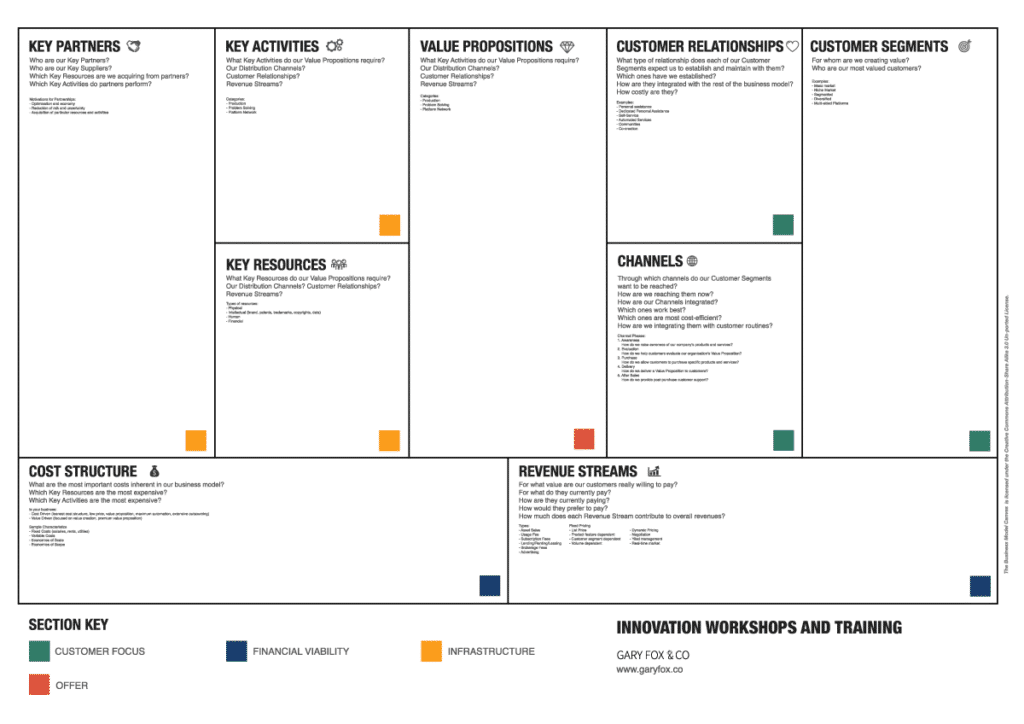
Whatever business model is finally chosen, it needs to be tested. Business models are rarely successful “out of the box” and must be fine-tuned. It is one thing to think of a value proposition, it is quite another to push the product/service into the market and see if customers will actually pay.
In fact, start-ups may need to transform the business model before they enable it to become a profit engine. This is part of the philosophy behind the lean startup.
Of course, mature companies face a different scenario.
4. Why Business Models Are Important?
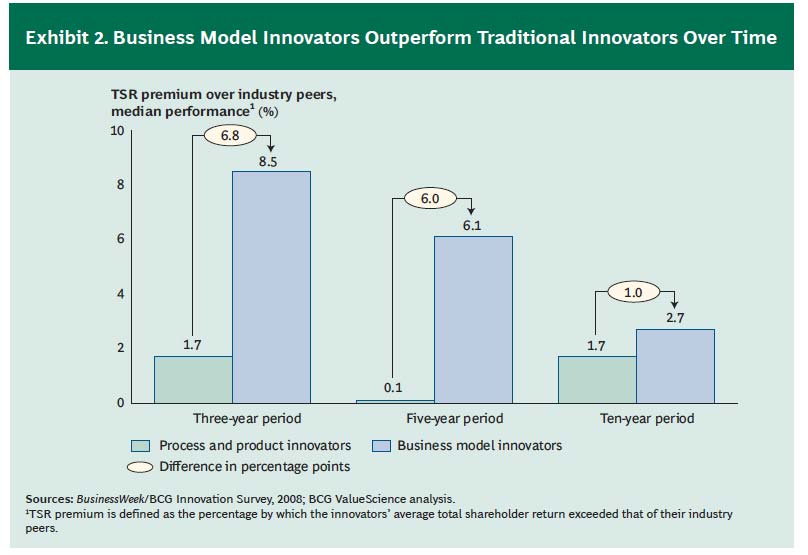
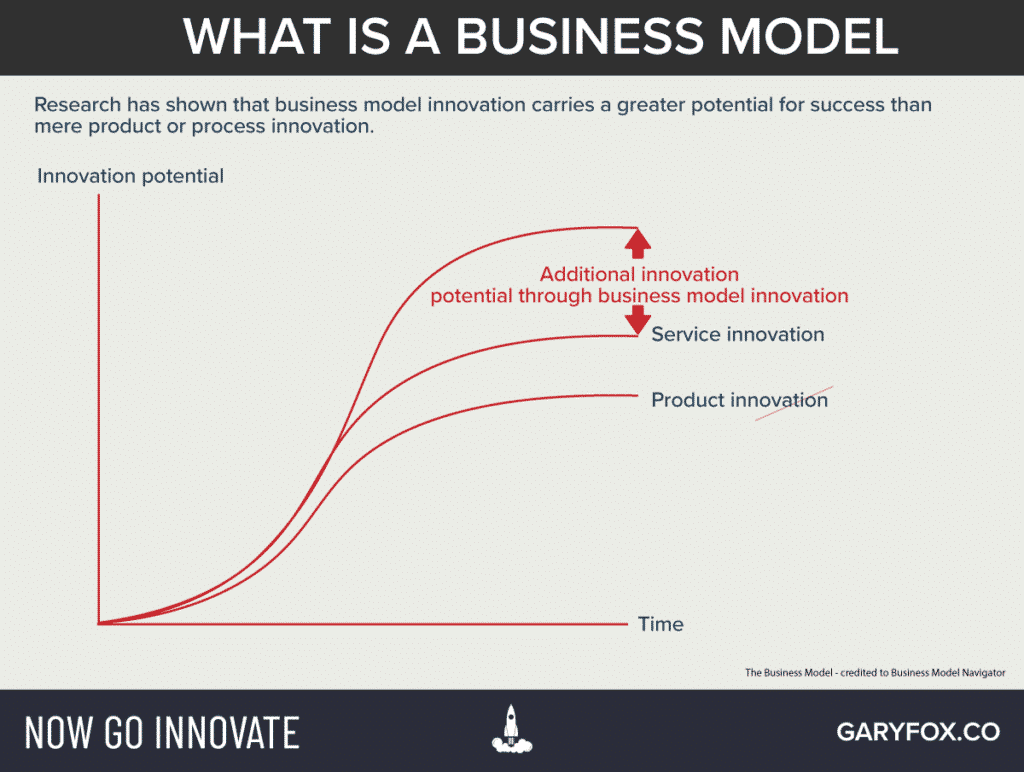
Business models offer the potential to create a competitive advantage, generate better returns and improve identification and development of innovative opportunities. Those are the hard benefits.
The soft benefits are that top management teams and entrepreneurs develop a shared understanding of a broad set of ideas, explore options and collaboratively make decisions.
Whether you are an entrepreneur or an executive, a business model helps you make better decisions about your business idea. The business model framework helps you to logically put together the pieces of a business, see how they fit together and then make decisions about which business model is the best fit for a strategy and market position.
If you look at how markets and companies have changed over the last two decades you realise that it isn’t the technology that disrupted the markets, it was the business models that new technologies created that caused the disruption.
Gary Fox
4.1 Benefits Of Using Business Modelling

A business model forces you to consider how you make money.
Source: Teece and Linden.
Having worked across lots of different companies I have witnessed the power of using business models to help teams structure and explore business ideas.
Of course, there are different frameworks for business modelling and so part of getting started with the process is to settle on a framework that you feel comfortable with.
- If you are a startup I recommend that you use the Lean Startup Canvas.
- If you are an established business then I recommend the Business Model Canvas.
- If you are a social enterprise then use try using The Flourishing Business Canvas or the Moonfish Circular Business Model.
No matter which one you choose the first step is to gain clarity and understanding of the overall concept, and how the elements of the model contribute to the overall business design.
I’ve listed below some of the benefits of using business models (in case you are sceptical).
4.2 Shared Understanding and Mental Models
A business is a complex system of parts and often people understand some parts better than others.
In large organizations, you can often have different departments, geographically dispersed business units and at any one time a series of different transformation projects running.
All these parts of the business form a business system that is constantly changing. Change one part and it often has a knock-on effect in other parts of the business. Without realising it a business can depart from the original business model but management may still be using an old mental model of how the system works.
As the famous quip suggests, “the map is not the territory.“ 3 Alfred Korzybski (1958) famous quip: “the map is not the territory.” .
Overtime management teams can lose touch with how these parts create, deliver and capture value. This is where understanding the business model comes in.
A business model simplifies the complexity and provides a structured approach to make decisions 4Martins, L. L., Rindova, V. P., & Greenbaum, B. E. 2015. Unlocking the hidden value of concepts: A cognitive approach to business model innovation. Strategic Entrepreneurship Journal, 9: 99–117..
Also, business models help people to understand the bigger picture and share a common mental model of how the business works. 5Massa, L., Tucci, C., Afuah, A., 2016. A critical assessment of business model research. Acad. Manag. Ann. http://dx.doi.org/10.5465/annals.2014.0072 annals. 2014.0072.:1.
4.2 Opportunities To Explore Innovative Ideas

Often teams will create a portfolio of ideas that then need to validating if they are worth pursuing. Although you may need to do more research, it’s a quick way to weed out bad ideas.
Over time a business will introduce many changes to the way it works. This can be as a result of strategic initiatives and a more general transformation program. However, these changes often fundamentally shift the business model.
Using a business approach top management teams can realign their understanding of the business and their competitive position.
Business models change in the market.
For established firms that means analysing the dominant business model in the market, identifying the beliefs that support and maintain it, then reframing how the elements can be combined to create new value opportunities.
The business model framework offers ways to explore how a business can innovate. Innovative thinking comes from combining different elements of the business model. Another useful way to explore new business models is to take a business model from another industry and see how it could be applied in your market. As an example, what would be the equivalent of an Uber in your market or an Amazon business model?
4.3. Create A Sustainable Advantage
Tomorrow’s competitive advantage of companies will not be based on
The Business Model Navigator – Oliver Gassmann, Karolin Frankenberger, Michaela Csik
products and processes, but on business models
Not every business model will create a competitive advantage nor will it be sustainable. Digital technologies and increasingly agile organisational forms enable firms to copy successful business models. Despite this, a first-mover advantage can lead to fast-growth and domination of a market6Markides, C. and Sosa, L. (2013) ‘Pioneering and First Mover Advantages: The Importance of Business Models’, Long Range Planning, 46(4), pp. 325–334. doi: https://doi.org/10.1016/j.lrp.2013.06.002..
It’s not bringing in the new ideas that’s so hard; it’s getting rid of the old ones.
John Maynard Keynes
In another section, I’ll cover what makes a successful business model. However, identifying the potential for a sustainable competitive advantage within a business model needs to be one of the main selection criteria.
4.4 Connects The Customer To The Value Proposition

Great businesses start with the customer and work backwards, while weak businesses start with the product. The business model places a huge emphasis on understanding the customer and creating the value proposition. That’s why Osterwalder and Pigneur subsequently went onto produce their book the Value Proposition Canvas.
Startups don’t fail because they lack a product; they fail because they lack customers and a profitable business model.
Steve Blank
Too many startups fail and corporate endeavours get junked. Research shows that one of the main causes is not understanding the customer. The benefit of using a business model is in the focus on the value proposition. From value proposition canvas to customer segments and then to test if there is a viable profit model.
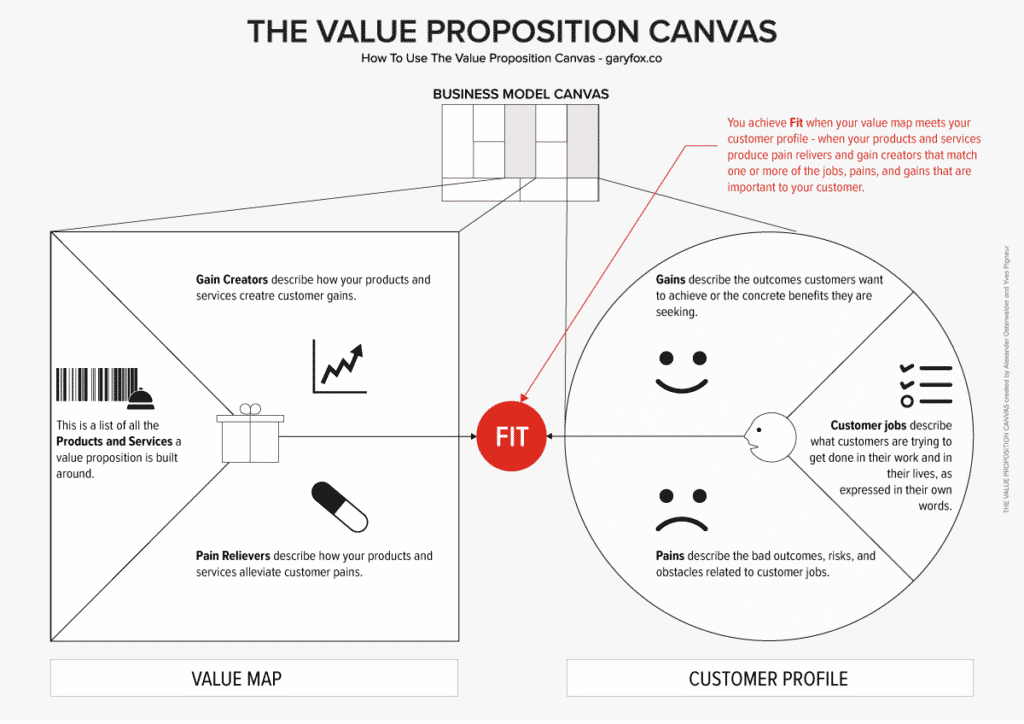
5. Why Some Business Models Are More Successful

Designing a better business model than your competitors is your primary goal.
But, long-term differentiation from competitors is increasingly difficult with products and services.
A value proposition alone isn’t enough. It’s equally difficult to obtain a competitive advantage from a great value proposition alone and more often than not it just gives you the right to compete.
How do you create a moat around your business with a superior business model? Strong business models use one or several Business Model Mechanics to deliver a competitive advantage that’s hard to beat.
The role of a business strategy is to make choices that optimize the long-term value of the business for its shareholders. The business is a tool to help analyze how to
5.1 Protecting Your Business Model

How does the design of your business model protect you from your competition? What is a moat?
Finding a ‘defensible moat’ then is one of the primary goals when creating and then selecting a business model.
Example 1: Although, it is known for selling hardware e.g. iPhones, iPads and Macs, their IOS software and a large ecosystem of application developers that create a library of apps that people use to customize their phone.
Example 2: The Amazon business model is based on its incredibly large global infrastructure that now represents a huge barrier for others. Furthermore, Amazon used this infrastructure to develop other business models such as AWS.
Assess the health of your current business model and how well it can be defended. How well can you defend your position?
5.2 Switching Costs

What are switching costs?
Switching costs are the costs a customer experiences when changing brands, suppliers, or products. Most people think of switching costs in terms of money, but it can also be time, level of effort as well as psychological barriers.
A switching cost can be significant especially in business to business environments. Changing a supplier runs the risk of disrupting normal operations of a business and often involves deep changes to internal processes. Often, as a result, a business will incur costs associated with training. As an example, a business changing it’s accounting software.
How costly it is for your customers to switch to another company’s offering?
Example 1: Facebook. Many people are heavily invested in Facebook. They have uploaded years of images (often linked to memories) and are connected to their circle of friends (messages and updates). Also, they can receive news and updates from a range of brands and interest groups. These represent high switching barriers. While some people may also use other platforms, many will not completely switch over completely and abandon Facebook.
Example 2: Probably the most famous example, at least until recently, was banks. Most people will move houses more often than they will switch banks. Why? The hassle and difficulty involved previously made it extremely time-consuming and difficult. The reason this is a good example is that now competitors have enabled that switch to be easier, thus they have reduced the moat.
How can you increase your customers’ switching costs OR reduce a competitors moat to steal market share?
5.3 Scalability

How rapidly and easily you can grow your business model without hitting significant barriers?
You are already familiar with how social networks like Facebook scaled their business. As a digital platform, the costs involved in increasing the users were low. This is called marginal costs.
Other platform businesses like Airbnb, Uber, eBay, Alibaba and Google have been able scale and become global businesses.
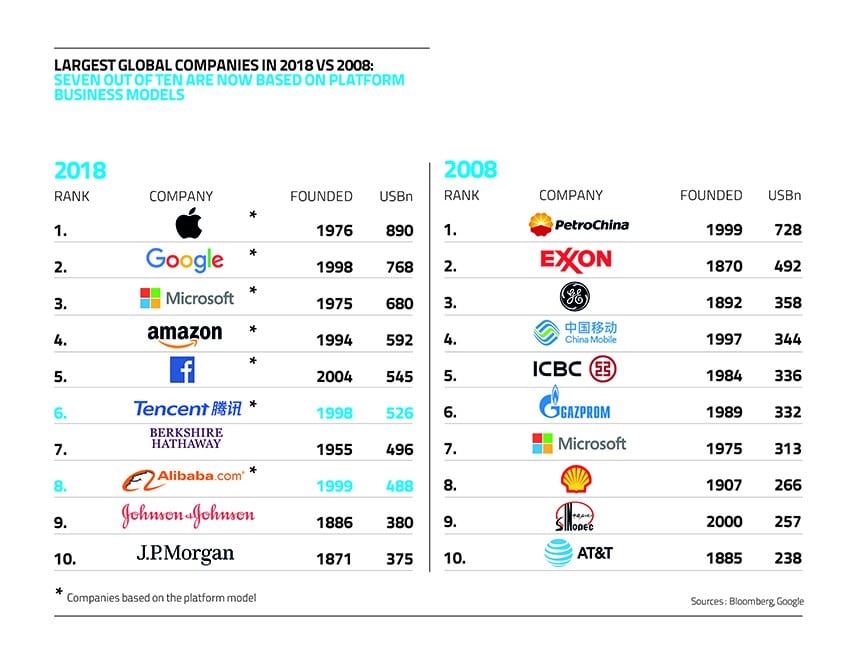
Digital platforms are among the most scalable business models. This is reflected also in terms of the number of employees relative to their user base and turnover. As an example, prior to being sold to Facebook, WhatsApp had around 400 million users but only employed 60 people.
In contrast, retailers that rely heavily on physical locations employ thousands of people and can’t easily scale because of the competition for prime retail locations.
What parts of your business model are scalable and which parts are not? Can the parts that are scalable be turned into a new solution either for existing customers or used to venture into new markets?
5.4 Earning vs Spending

Do you generate revenues before you incur the costs of producing and delivering your value proposition to customers?
Typically this type of business model is enabled through customization. Increasingly new technologies have enabled more modular builds of products.
Examples:
- Shoes and clothing – You can now order custom made Levi jeans and customizable Nike shoes.
- Laptop or PC – Dell with their range of custom made, just-in-time, customizable range.
- Vitamins – Persona Health with vitamins made for you.
How can you earn more before spending?
5.5 Recurring Revenues
Recurring revenues trump having to constantly win transactions (one-off sales). This is the principle behind subscription business models and the success of subscription companies like Spotify, Amazon Prime and Netflix.
For Software as a Service (Saas) companies, think Microsoft and Adobe, the market has shifted to subscription model having traditionally been rooted in transactional costs based on new versions fo their software.
Can you turn any part of your business into a subscription model and create a recurring revenue stream?
5.6 Others Do The Work

How much of your business model gets customers or third parties to create value for you (for free)?
Example 1: Many of the social media networks rely on the production and sharing of user-generated content (UGC) to drive their business model. Advertising is the key revenue generator for YouTube, but the user content, sometimes brands, is the driving force behind getting an audience that is then willing to view ads.
Example 2: IKEA changed the furniture market by getting customers to assemble the furniture themselves. All IKEA had to do was to produce the furniture in such a way as to make it easy to assemble. Equally important was their use of their retail space which provided designed areas, e.g. living rooms, dining areas and bedrooms, using their furniture.
How can you get others to do more work for you?
5.7 Seismic Cost Structure Changes

How can you change your cost structure to be substantially different or better than that of your competitors?
Example 1: Up until Whatsapp, telecoms companies relied heavily on making revenue from SMS messages. Not only that but they often placed limits on the number of messages you could send.
Cleverly, Whatsapp realized the opportunity to send messages for free using the phone’s cellular or Wi-Fi connection. Essentially Whatsapp used the existing infrastructure of the carriers to provide their service.
Example 2: Nike trainers were traditionally made from 30-40 pieces which were then stitched together in cheap sweatshops. Not only was this a labour-intensive it also involved lots of different suppliers and logistics. Nike then using ‘micro-level precision engineering’, created their Flyknit shoes. The entire upper part of the shoe is made from a single knitted piece. This reduced production and logistical costs. Not only that, but the shoes were lighter overall and gave performed better for the user.
How can you revolutionize your cost structure rather than just trimming it? Are you aware of potential competitors that might disrupt your business model with a fundamentally different cost structure? What can you turn into a variable cost?
6. The Business Model Canvas Explained
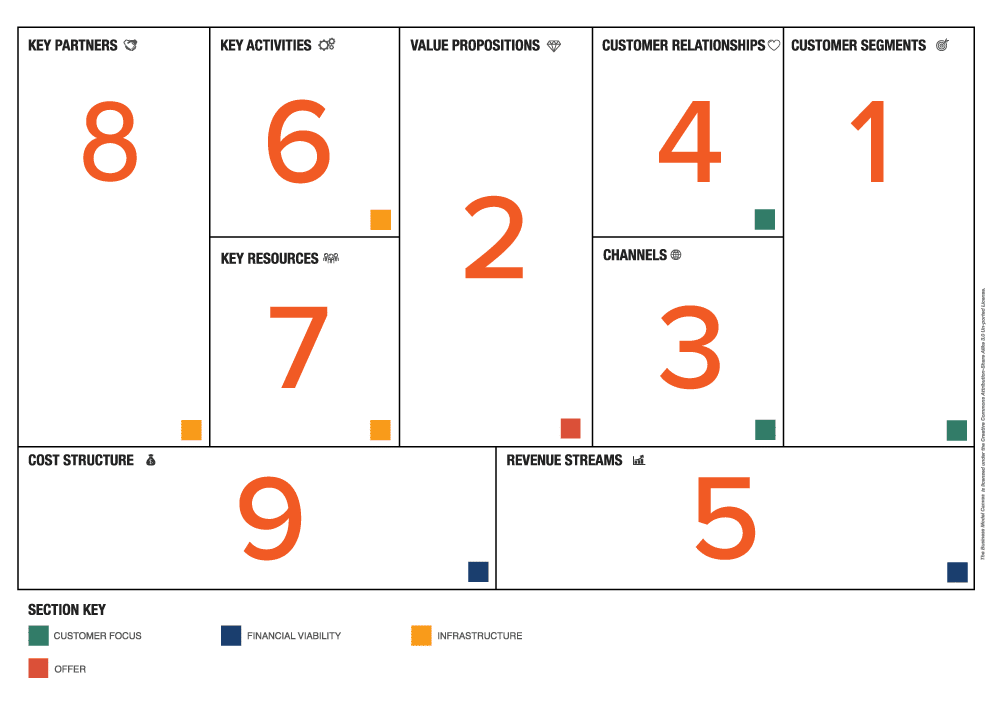
Together the nine sections form a business logic that maps out the decisions about the different parts of the business and how they come together to form the business model.
- Customer Segments
- Value Proposition
- Channels
- Customer Relationships
- Revenue Streams
- Key Activities
- Key Resources
- Key Partnerships
- Cost Structure
Simplifying this further gives us three boxes.
- Feasibility – how do we organise resources to create value?
- Desirability – who are our customers and how does our offer fit to their needs?
- Viability – is this a profitable opportunity?

To understand how to use the business model canvas – see my guide and the step by step instructions.
7. Business Model Canvas Alternatives
7.1 The Flourishing Business Canvas
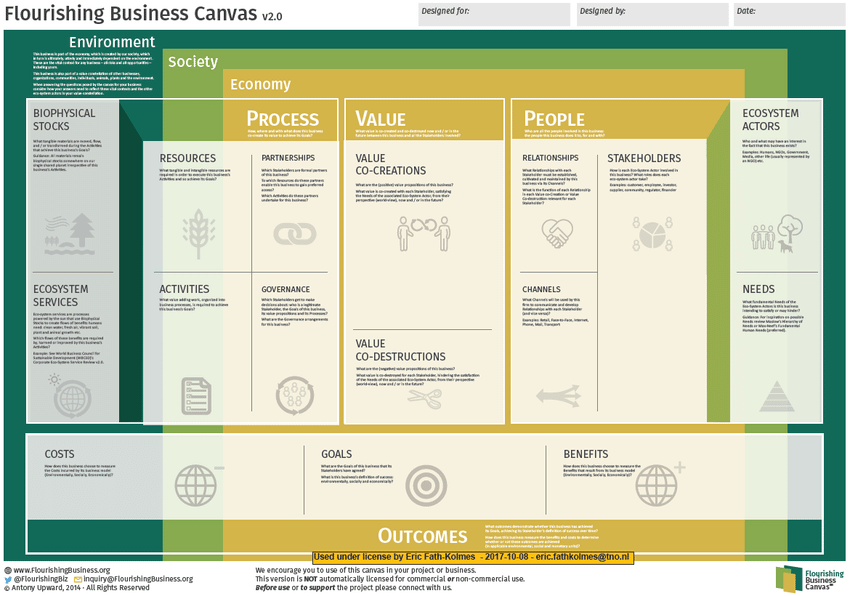
The Canadian researchers deconstructed the Business Model Canvas and re-assembled it by adding dimensions of sustainability thinking. They argue that the 9 building blocks of the Business Model Canvas help a company to “do well” but in order to “do good”, 5 more questions are required.
In order for a company to do “well” and “good”, only five more questions were added to the existing 9 of the business model canvas which resulted in the 16 new building blocks of the Flourishing Business Model Canvas that takes respect of the economy, society and environment. The building blocks are valued co-creation and co-destruction, relationships, channels, stakeholders, ecosystem actors, needs, partnerships, governance, resources, activities, biophysical stocks, ecosystem services, goals, benefits and costs.
7.2 Fluid minds framework for a successful business
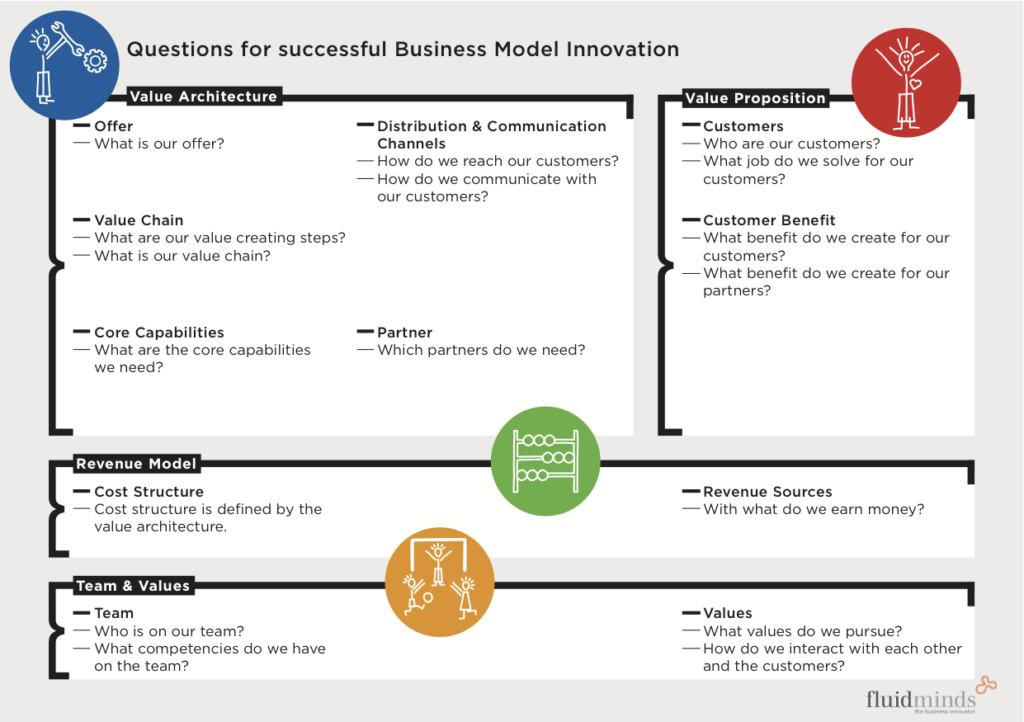
The BMF sets the focus on a company’s values, therefore it depicts the value proposition for the customer, but as well the architecture and the value chain. Unlike other BMF it as well shows the internal values of the company. In each building block except the revenue model, the BMF explores different aspects of the value creation.
7.3 Business Model Navigator
The Business Model Navigator framework focuses on answering four associated questions:
- who is the target customer?
- what do you offer to the customer?
- how is the value proposition created?
- why does the business model generate profit?
7.4 The Lean Startup Canvas
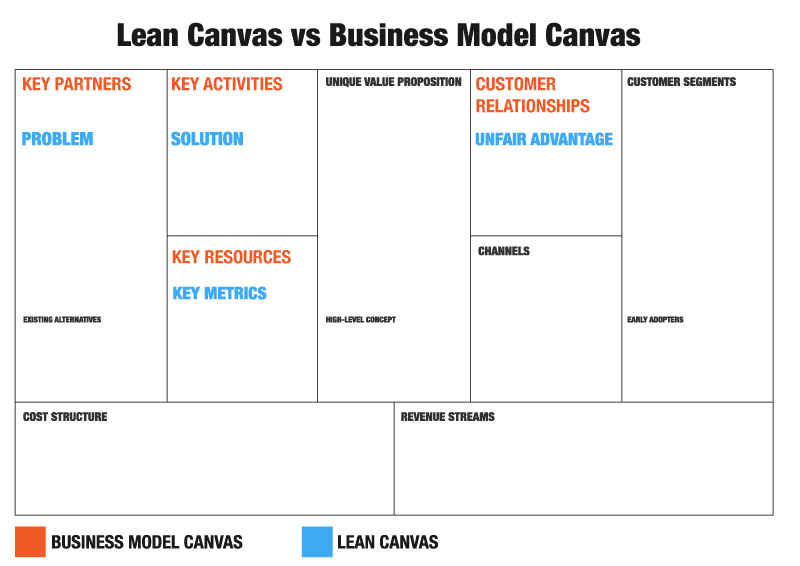
One of the reasons for the success of the business model canvas is that it provides a framework and structure to guide though.t –7Martins, L. L., Rindova, V. P., & Greenbaum, B. E. (2015). Unlocking the hidden value of concepts: A cognitive approach to business model innovation. Strategic Entrepreneurship Journal, 9, 99–117.
Many entrepreneurs have struggled with the Business Model Canvas because assumes that an organisation exists. For this reason, Ash Maurya created the Lean Startup Canvas. The Lean Canvas promises an actionable and entrepreneur-focused business plan. It focuses on problems, solutions, key metrics and competitive advantages.
For more details take a look at how to use the Lean Startup Canvas.
7.5 Moonfish Circular Business Model
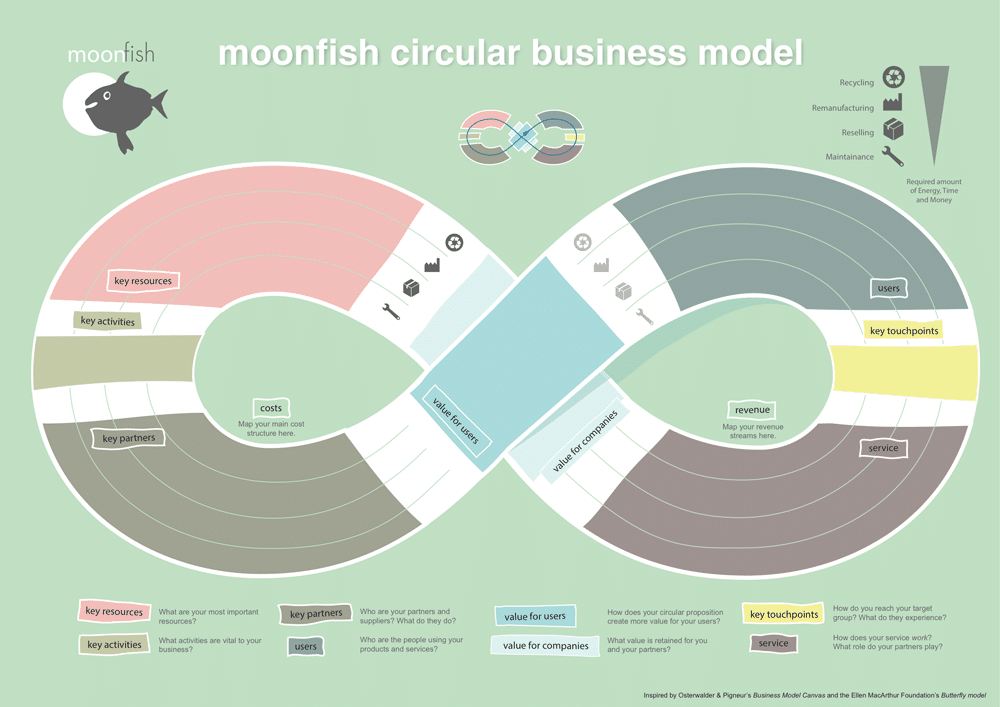
This business model tool is based on Osterwalder & Pigneur’s Business Model Canvas and the Ellen MacArthur Foundation’s Circular Economy System Diagram. It shows different cycles of maintenance, reselling, remanufacturing and recycling. The framework takes after the infinity symbol, in order to emphasize the ongoing process of circular business (it never ends). The smaller cycles require less time, money and energy. The value of the Circular Economy is embedded in each of the four cycles.
8. What Is Business Model Innnovation?
Business model innovation is a concept used to find new ways to generate value and profits by transforming its capabilities. There is no generally accepted definition of business model innovation which makes it hard to analyse and measure 8Fifteen Years of Research on Business Model Innovation: How Far Have We Come, and Where Should We Go? Foss, N. J., & Saebi, T. (2017). Journal of Management, 43(1), 200–227.
The easy way to think of Business model innovation is as a process and as an outcome.
8.1 Business Model Innovation Process
In times of change learners inherit the earth; while the learned find themselves beautifully equipped to deal with a world that no longer exists.
Eric Hoffer
The average life of a S&P 500 company has fallen from almost 60 years old in the 1950s to less than 20 years currently.
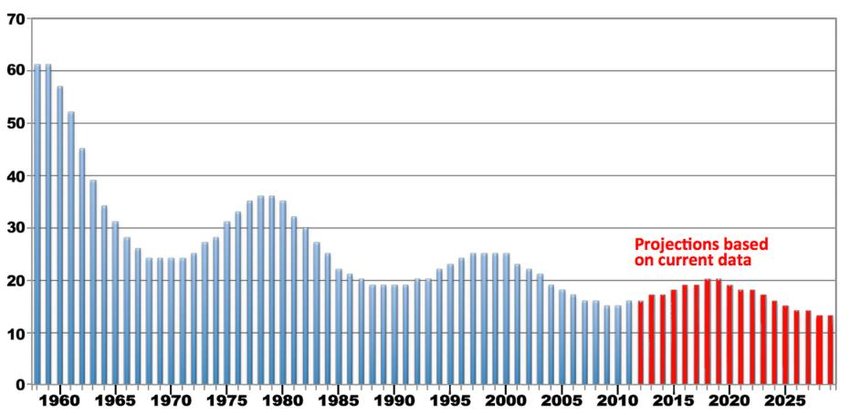
Emerging technologies empower entrepreneurs to create new business models that disrupt markets. For established firms, the implications are dramatic. Either adapt or die. Large organisations are being attacked on all sides as startups create new business models that unbundle their value chain.
Business model innovation is focused on enhancing advantage and value creation by making simultaneous and mutually supportive changes both to an organization’s value proposition to customers and to its underlying operating model. At the operating model level, the focus is on how to drive profitability, competitive advantage, and value creation through decisions on how to deliver the value proposition:
- Where to play along the value chain
- What cost model is needed to ensure attractive returns
- What organizational structure and capabilities are essential to success
The process of business model innovation is focused on how firms can transform from their existing business model into a new business model. This is not the same as merely creating a new product or service, although that may be a part of the process.
The business innovation process involves making strategic choices based on the analysis of markets and internal capabilities.
Opportunities that can be explored are:
- White space growth opportunities – identifying entirely new customer opportunity with a completely new business model that changes the competitive landscape. E.g. Mars moving into pet foods and then buying pet hospitals.
- Generate value through new ideas – develop transformative innovative business models that fulfil the jobs customers need to get done more effectively, efficiently and profitably.
- Successfully enter emerging markets – re-conceiving business models that recognize the unique unmet needs of consumers in these markets, profitably and efficiently. E.g. Go Pro as part of the growth in portable drones and cameras.
- Create new systems, rules, and metrics – harness new ways to organize and launch a new venture with an innovative business model.
Unlike other types of innovation, changes to the business model require changes to the fundamental principles that underpin how the business operates. However, most innovation is incremental, such as product innovation, where technology enhancements are routinely included in product updates as a way of increasing performance or reducing costs.
Business model innovation transforms how value is created, delivered and captured by reinventing the dominant logic of the business.
Essentially it can be broken down into four easy to understand stages which have been adapted from the Lean Startup and his follow up book The Startup Way.
#1. Customer Discovery – Identify a customer segment with a problem and work set out assumptions that underpin their problem.
- Profile customer and segments
- Define their characteristics – demographics, psychographics and behaviours.
- Set out a clear problem statement
- Define the jobs to be done – outcome, pains and gains.
See the persona canvas for more details on how to do this.
#2. Problem and Solution Fit – Develop a solution to their problem that they would pay, is profitable and sustainable.
- Identify how to solve the problem the customer faces.
- Produce a clear value proposition.
- Pain killers – how you solve the primary pain.
- Gain creators – the extra value your solution provides compared to alternatives.
- The costs associated with your solution.
- What is an unfair advantage?
#3. Product Market Fit – Verify channels through which the customer can be reached for sales and delivery of the solution.
- Identify how your target customer will become aware of your solution.
- How you will communicate the brand and position the solution compared to the competition.
- How you will deliver the overall customer experience – including post-purchase support and retention tactics.
- Identify the cost of acquisition and customer lifetime value.
#4. Structure and Scale – resource and structure to support the scaling of operations.
- Resources needed – people, time, money
- Set out key processes
- Protection of intellectual property to practice idea
- Partners to sustain and grow model
Business model innovation processes can be approached in any number of different ways as long as sound business principles remain intact. These sound business principles are framed by four core business principles:
- Customer Value Proposition: Create new and unique value for the customer;
- Profit Model: Make a profit
- Key Resources: Secure the resources required to deliver the customer value proposition; and
- Key Processes: Identify the core business processes required to deliver the value proposition.
Think of these four areas as a picture frame for the business model innovation process, where it’s up to the company to paint the picture within the frame.
8.2 Business Model Innovation Outcomes
Business model innovation describes a fundamental change in how a company delivers value to its customers, whether that’s through the development of new revenue streams or distribution channels.
There are lots of case studies and examples of how new entrants have challenged and often superseded existing companies as a result of an innovative business model.
Most of the research points to business model innovation as providing:
- improvements in corporate profits 9Impact of knowledge brokering on performance heterogeneity among business models. Management Decision, 50, 1649–1660.
- improvements in growth and market share.
- improvements in operational efficiency and effectiveness and customer lock-in.
- cost reduction and strategic flexibility.
- rapidly exploit new market and product/service opportunities.
- move from fixed to variable costs.
9. Why Business Model Innovation Is Important
Organizations that are locked into a dominant business model are in danger of having a similar fate as Kodak. The company once successful company was a giant in its time accounting for 90 percent of film and 85 percent of camera sales. However, Kodak viewed itself as untouchable. Moreover, it viewed its core business as being in the film and chemical business.
It’s hard to believe now that their own engineer, Steven Sasson, created the first digital camera! Executives were nervous that digital cameras would cannibalize their existing product and main revenue stream. So they ignored the business opportunity. As a result, competitors quickly seized market share and Kodak was later forced to file for bankruptcy.
Many failed business model innovations involve the pursuit of opportunities that appear to be consistent with the firms current business model.
In contrast, companies like Uber, Airbnb and Xiaomi have been able to dominate their respective industries because of their unique business models.
The Economist Intelligence Unit (2012) surveyed more than 4,000 senior executives worldwide on the subject of innovation. The findings highlighted that executives expect new business models to provide a long-term advantage, not new products and services.
10. Why Digital Business Models Are Game Changers
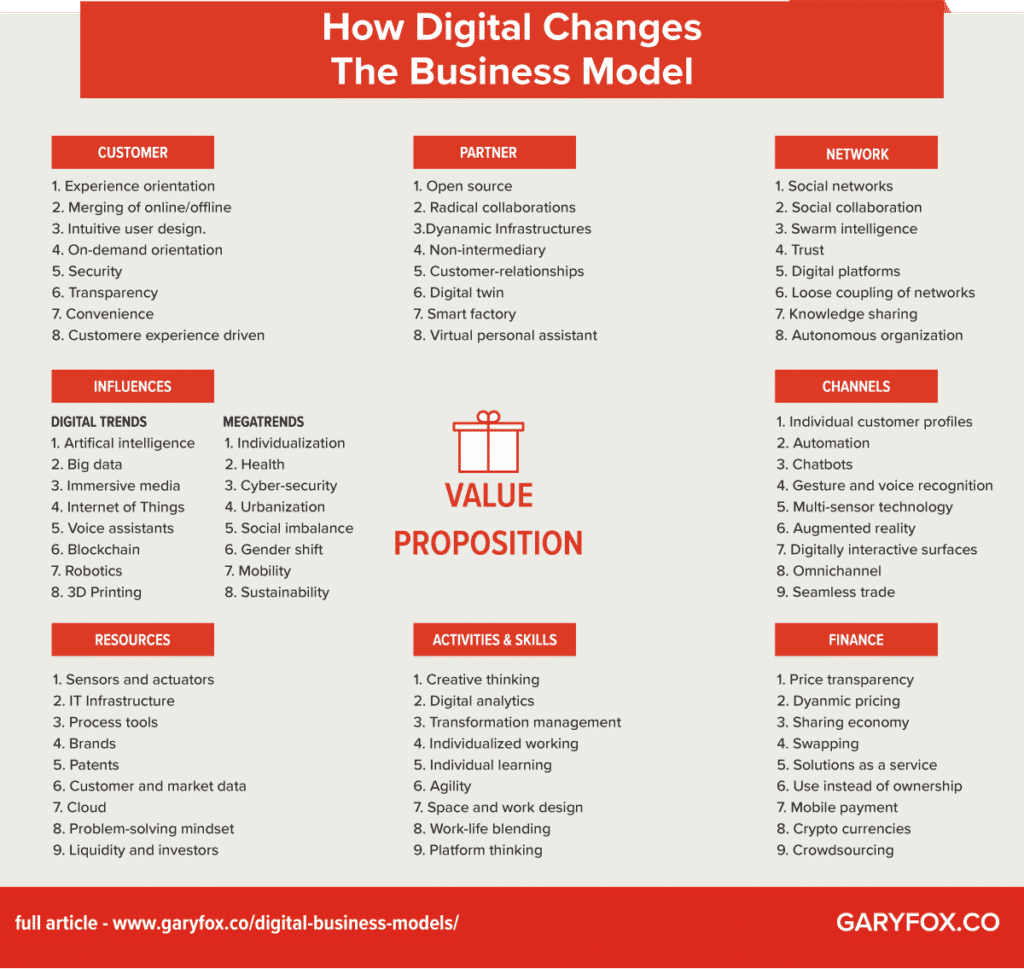
Technologies used to be local e.g. a server used to be based in a company and enable file sharing around the building. Even then there were problems with sharing data across departments as they used different proprietary software.
Fast forward to today and cloud computing, global infrastructures (AWS, Google…), modular digital building blocks and easy inter-connectivity via API’s have unleashed an unbelievable number of new business models.
10.1 How Does Digital Change Business Models?
This is the area of my doctoral research and something I’m obviously passionate about.
First of all, let’s explore some of the digital business models that exist today and how digital technologies enable them. I’ll also illustrate this with some examples.
Consider how digital technologies change systems, structures, activities, as well as processes. As an example, digital channels change the way to the market, which subsequently affects how you create value for your customers.
Example 1: Retail channel. Online retailers, such as Alibaba and Amazon, have changed how people source or buy products. Many retailers have not been able to adapt and have gone bankrupt as a result, including big names such as former retail giants such as Toys‘R’Us, Claire’s, and RadioShack and many more.
Example 2: Mass Customization: Digital technologies allow consumers to design and customizing products, perform last-mile distribution activities through technologies such as 3D printing.
Example 3: Digital Assistants: AI-based technologies, like Amazon’s Echo and Google Home, are fundamentally shifting how consumers search, interact and use product and services.
Example 4: Industry 4. Sensors, AI, robotics and other automation technologies converge to transform businesses across the value chain.
10.2 Some Useful ways to think about digital business models
10.2.1 MALLEABLE (PRODUCE IT, CHANGE IT, DISTRIBUTE IT)

The music industry has been completely transformed as the music moved from physical records to being digital. As a result of digitization, music moved music from being physically constrained and entwined with a vinyl disc to being a set of digits (zeros and ones).
- Instead of going to a record store to buy an album you can now buy it on any number of devices and through multiple channels e.g. Apple Music, Google Play.
- Digital music distribution means you can freely distribute music instantly and globally at a fraction of the cost it would take to distribute physical albums.
- Any number of apps exist to play music on multiple devices.
- Instead of owning the music you can rent it as a subscription and get access to thousands of albums (Spotify).
- Your garage or living room is no longer needed to store hundreds of albums, you can use digital players (Smartphones, wearables, iPod).
Digital separates form (physical) from function (what something does). Examples, music is no longer tied to physical albums, books now can be purchased online and viewed on Kindle app or other eBook players, movies can be streamed on-demand instead of being on a DVD, cash now has changed to NFC (wireless) payments (Apple Pay)…
10.2.2 DISINTERMEDIATION (CUT OUT THE MIDDLEMEN)
Cutting out layers of management or layers within an industry saves masses of costs. That’s why cryptocurrencies (aka blockchain) promises to be such a game-changer. Instead of having to use banks they hold the promise of being able to directly transfer money between parties.
Disintermediation can work the other way, as was the case for Homejoy which shut down in 2015. Homejoy was a platform that connected house cleaners with homeowners. Imagine that you hire a house cleaner from Homejoy and are satisfied with the service. Would you really go back to Homejoy to hire the same person again? There’s little incentive to return to the platform. Additionally, after obtaining enough clients from a platform to fill his or her schedule, the house cleaner doesn’t need that platform anymore. This was exactly the problem that doomed Homejoy.
10.2.2. MODULARITY (RECOMBINE and Remix Things)
Recombination is at the heart of innovation.
What can you combine to create new sources of value or to change processes? Recombination in the physical world is difficult but in the digital world, you can combine lots of different things.
Example: Remix Uber – change houses to boats and you have
10.2.3. GENERATIVITY (PEOPLE SHARE THINGS, WORK TOGETHER AND FORK IT)
For example, a developer can use a Google Maps API to insert a link to a map providing driving directions on a website to solve the problem of navigation. A new developer may take the same app and add new features such as police sightings or construction warnings to address a different problem (of avoiding speed traps). Each evolution incorporates the memory of what has gone before with a new distinct problem-solution pair.
10.2.4 Physical Product AND Digital Sensor
New digital business models will challenge incumbent firms as they are burdened by their legacy business model and the related difficulties in transforming to a new business logic.
Typically incumbents are forced to deal with conflicts and trade-offs between existing and new ways of doing business10
In many cases, the digital will require a marked departure from the status quo and lead to the failure of existing business models 10 Business models, business strategy and innovation, D.J. Teece, Long Range Planning, 43 (2–3) (2010), pp. 172-194.
10.2 Digital Trends and Digital Business Model Innovation
10.3 How To Discover Digital Business Models
There are four phases for innovating new digital business models: discovery, development, diffusion and evaluation of impact.
- identifying existing products and services;
- deconstructing business models; and
- discovering new configurations.
10.3.1. Identify existing products and services
First, products and services from within the target market must be identified and defined from the customer’s perspective. Offerings that match a customer need to be understood. Then products and services recorded that have similar business models; it is more important to capture the variety of options for designing business models than to achieve an exhaustive market overview. As digital innovations are often enhancements of non-digital products and services, non-digital counterparts must be included.
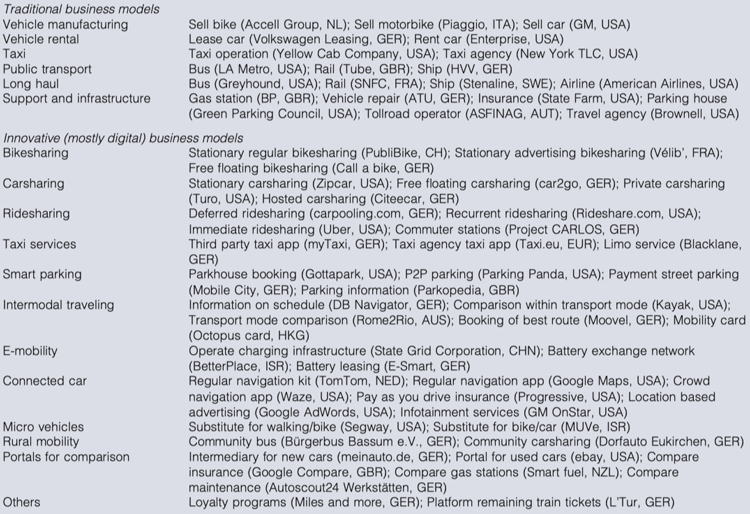
10.3.2. Deconstruct the business models
Second, the business model components of the products and services identified must be decomposed by applying the taxonomy-building methodology 11 A method for taxonomy development and its application in information systems”, Nickerson, R.C., Varshney, U. and Muntermann, J. (2013) European Journal of Information Systems, Vol. 22 No. 3, pp. 336-359.
Common characteristics of the selected products and services are identified and grouped into dimensions. Finally, the resulting taxonomy is visualized as a matrix listing several dimensions of a problem and the variety of possible values for solution.
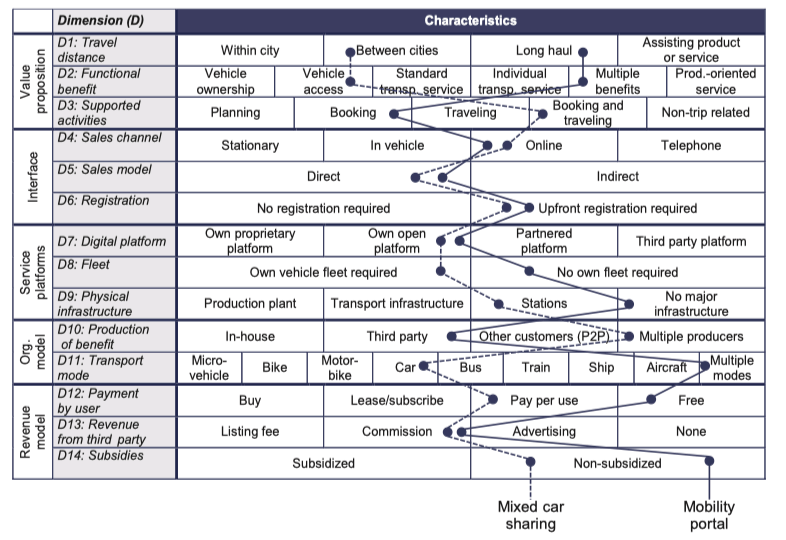
10.3.3. Discover new configurations
The resulting matrix then can be used to spot commonalities and differences between business models. The most important commonality relates to the value proposition because it reveals which offerings compete for the same customers.
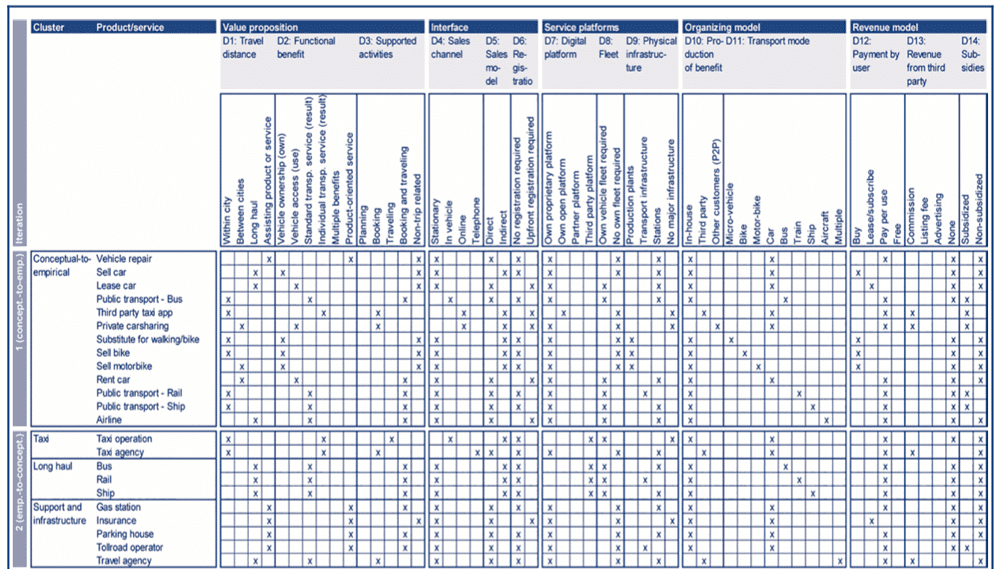
11. How Many Types of Business Models Are There?
See my next article for the ultimate list of business model types and examples for a full list of examples and how to harness the power of these types to create innovative new business models. For now, I’ve listed them as most others do, but there is a far better way to think about business models – I’ll show you soon.
The number of business models available to any business is shifting because of digital technologies. Of course, there are examples and some cases of types of business models and I list this in the example.
There are some broadly-based business models that have labels. The problem though is that often these labels, e.g. subscription model, don’t really define the success and performance of a business.
Many businesses incorporate multiple business model labels. As an example, Spotify:
- A multi-sided platform.
- Uses subscription services.
- Offer peer-to-peer connectivity.
- Freemium model
- Advertising
Business Model Examples
11.1 Types Of Business Model (A – Z)
- Advertisement – most media publications online, e.g. Forbes, generate revenue from advertisements on their site.
- Affiliate Marketing Business Model – is used by many software companies, manufacturers and eCommerce sites (including Amazon). An affiliate promotes a product or service to their audience and upon purchase receive a commission.
- Agency based Business Model – this is where companies outsource parts of their business to agents who undertake the service on their behalf. Examples include advertising agencies such as BBDO, TBWA as well as outsourced events, direct sales, telesales…
- Aggregator Business Model – is where the company aggregates providers within a niche and then sells their services under its own brand. The money is earned as commissions. Examples – Uber, Airbnb, Oyo.
- Attention Merchant Business Model – is based on the principle of ‘grabbing’ attention, usually online, and then using this to monetize the business. Examples include the rise of influencers where they have become a brand in their own right and monetize the attention through sponsorships and affiliate payments.
- Blockchain – The Blockchain is an immutable, decentralized, digital ledger. The blockchain can cut out middlemen such as banks and provide peer-to-peer transactions. The blockchain opens up lots of new business model opportunities because of the decentralized approach. Models based on blockchain are not owned or monitored by a single entity. Rather, they work on peer-to-peer interactions and record everything on a digital decentralized ledger.
- Brick-and-mortar – bricks and mortar refer to physical buildings either owned, rented or leased. Many businesses such as hotel chains have large amounts of capital tied up in physical properties. Also retailers, restaurants and many other businesses.
- Bricks-and-clicks – bricks and clicks are a blend of physical channels and online. Typically, many retailers have moved online. Grocers – Tesco, Walmart as well as fashion brands – Apple, Ted Baker operate both physical stores as selling their goods online. Interesting that Amazon, which started online is now opened up a physical store which could be a major threat to many retailers.
- Cash Business Machine Model – This is where the timing of payments to suppliers is much longer than when a business collects money from its customers. In other words, the company gets the money in first before needing to pay for the goods it sold. As an example, Amazon takes 82 before after receiving goods before it pays suppliers, but on average an item will be sold within 36 days from stock.
- Consulting Business Model – consulting is a major business sector with companies such as Accenture, McKinsey, Deloitte, Bain and many others. These companies focus on specialist skills and knowledge, often within industry verticals. Their help organizations navigate change, develop strategy, manage mergers and acquisitions and many other services.
- Crowdsourcing – involves getting the ‘crowd’ often the public to help contribute to a project. There are different types of crowdsourcing platforms – some are for social causes and others purely focused on helping startups. Companies that rely on crowdfunds are Wikipedia. There are lots of other crowdfunding tools that entrepreneurs can use.
- Data Licencing / Data Selling – companies like Twitter and Facebook license access to their platform to third parties. Other businesses work on licensing include companies that create license their patents to companies that then use the intellectual property in a manufacturing process.
- Direct sale business model – direct sales are most often associated with business-to-business environments where the purchase of services and complex products runs from thousands to millions of dollars. Salespeople are a vital part of customer acquisition and further development of customer relationships.
- Direct to Customer Business Models – the consumer goods industry is based on distribution and sals of products to consumers, as opposed to businesses. However, companies like Hp were disrupted in the laptop and home PC market when Dell sold directly to consumers. Hp had traditionally based it business on selling to consumers through large retail stores.
- Distributor – there are hundreds of distributors that act in most part as middlemen. As technology has advanced the role of many distributors has changed. In fact, Alibaba now provides a direct connection between suppliers and sellers and has cut out the need for many distributors. Many businesses outsource their distribution to specialists (often called logistics companies).
- Dropshipping – is an e-commerce business model where an online store is set up to sell products from other companies. However, no stock is ever purchased. Instead, once the order is placed it is sent to the manufacturer, or distributor, who then fulfils the order. An example of this is Aliexpress – a part of the Alibaba group.
- E-Commerce Business model – eCommerce business model is an up-gradation of the traditional brick-and-mortar business model. It focuses on selling products by creating a web-store on the internet.
- Educational Niche business model – The ease of producing courses has prompted lots of entrepreneurs to set up online courses within niche markets to educate others. Online platforms, like Udemy, have also created marketplaces for online educators
- Franchising Business Model – the franchise market is huge. A franchise operation creates a business and which then acts as the blueprint for operation. This blueprint then is purchased or rented. The original business then acts as the marketing and sales part of the operation to help its franchisees develop and grow. Examples are McDonalds, Papa John’s, Starbucks and Pizzahut.
- Freemium Business Model – a lot of businesses know that you are more likely to buy if you try their products. Usually, this is for software as a service (SaaS) businesses who offer a cut down version of the features so you can get to see if it is a good fit for your needs. Example: Canva.
- Hidden Revenue Business Model – as the name suggests this business model relates to hidden ways the business makes money, or so you think. Examples are Google and Facebook who both base their business model entirely on advertising revenue. Every time the customer views or clicks on an ad they charge the business who is advertising.
- Instant News Business Model – Twitter as a social network is used to track news much more so that Facebook. It is more ‘in the moment’. Other platforms such as InShorts also capitalize on this and hence create a different value proposition and model.
- Manufacturer – manufacturers make finished products from raw materials. They then sell either directly to the customers or sell it to third parties. Car manufacturers produce cars and also sell cars through car dealerships.
- Network Marketing – or multi-level marketing involves a pyramid structured network of people who sell a company’s products. The model runs on a commission basis where the participants are remunerated when. Network marketing business model works on direct marketing and direct selling philosophy where there are no retail shops but the offerings are marketed to the target market directly by the participants. The market is tapped by making more and more people part of the pyramid structure where they make money by selling more goods and getting more people on board.
- Online Marketplace – Online marketplaces aggregate different sellers into one platform who then compete with each other to provide the same product/service at competitive prices. The marketplace builds its brand over different factors like trust, free and/or on-time home delivery, quality sellers, etc. and earns commission on every sale carried on its platform. Examples – Amazon, Alibaba.
- Multi-Brand Business Models – Companies these days want to serve all categories of people. To save this purpose companies need to have all sorts of brands which resonate with all categories of customers. Not everybody would afford Puma Shoes, for example, hence many retail outlets have started to keep multiple brands in the same store so that the users can have a choice and the retailers can have a business. Lifestyle and Pantaloons are few other examples which follow multi-brand business model strategy.
- Multi-Sided Platform Business Model – These types of Business Models act as invisible middlemen who ensure smoother transactions in interactions among buyers and sellers. One of the best examples would be LinkedIn. The business social network is an undoubted market leader in its platform which allows job seekers and companies to interact “socially” in a “business sense.”
- Nickel-and-dime – In this model, the basic product provided to the customers is very cost-sensitive and hence priced as low as possible. For every other service that comes with it, a certain amount is charged. Examples – All low-cost air carriers.
- On-Demand subscription-based Business Model –
- One for One Business Model – The best example would be TOMS shoes which give out one pair to the kids around the world cannot afford them for every pair of shoes sold. This move has made the company very profitable and sustainable over a long time is it improves the brand image in the minds of people. The nonprofit side of the business is excellent for revenue generation.
- Peer to Peer Business Model – A P2P economy is a decentralized internet-based economy where two parties interact directly with each other to buy or sell goods or to conduct a transaction without the intervention of any third party. A P2P catalyst is a platform where these users meet. Examples of P2P platforms are Craigslist, OLX, Airbnb etc.
- Privacy as Business Model – Privacy has become the biggest need in recent times and with the evolution of technology. With Google and Facebook gathering uses data the concerned is legitimate for all the people about their privacy. In this respect, many of the businesses are started evolving which allow users to control privacy better than popular businesses. Free sample over Google privacy concerns, a search engine like duckduckgo have started evolving which allows users to control the data and private navigation. Duckduckgo makes money via associations and by sales of local keywords. Does privacy has become a business model for duckduckgo.
- Razor and Blade revenue Business Model – In Razor and Blade business model, the company makes the customer product loyal and sells the related accessories at a premium price. This can be compared to the razor and blade, where razor is a onetime purchase but the blade is a constant purchase and thus company ensures a constant stream of revenue by pricing the blade at a premium.
- Retailer – A retailer sells directly to the public after purchasing the products from a distributor or wholesaler. Examples – Amazon, Tesco.
- Reversed Razor and Blade revenue business model – As the name suggests this is the type of business model that is exactly opposite to the other one mentioned. Apple charges very high on its physical products why it gives out the music on iTunes for apps on Appstore for a very low cost which is a constant purchase. So in the case of Apple, the one-time purchase is more expensive than the regular purchases which are in fact Reversed Razor and Blade business model. This is one of the strategies that helped Apple grow and become a trillion dollar company.
- SAAS, IAAS, PAAS – Many companies have started offering their software, platform, and infrastructure as a service. The ‘as a service’ business model works on the principle of pay as you go where the customer pays for his usage of such software, platform, and infrastructure; he pays for what and how many features he has used and not for what he hasn’t.
- Subscription-based Business Model – Suppose there is a course for $10 and you sell that course to 10 people, you will earn $100 for one month. Next month you will have to come up with new buyers for the course without which there would be no revenue. Instead of this course is converted into a subscription-based business model, the course sections can be given to students for $3 per month. This way with 10 subscribers you have $30 fixed revenue for subsequent months and as users keep on adding the revenue keeps on growing. Amazon Prime and Netflix run a similar business model.
- User-generated Content Business Model – These types of Business models work entirely on user content. People come on these websites to know about information and that information is provided by other people themselves. The best example is Quora which is termed as Social QnA site. The concept comes from Wikipedia where users use their knowledge to edit certain articles and share their talent for others to read. Blogs are another example of the user-generated content business model.
12. Summary and Actionable Points
This was a long article so I’ll wrap up the key points and takeaways that you can action.
